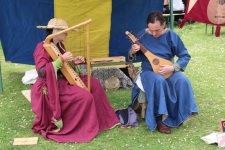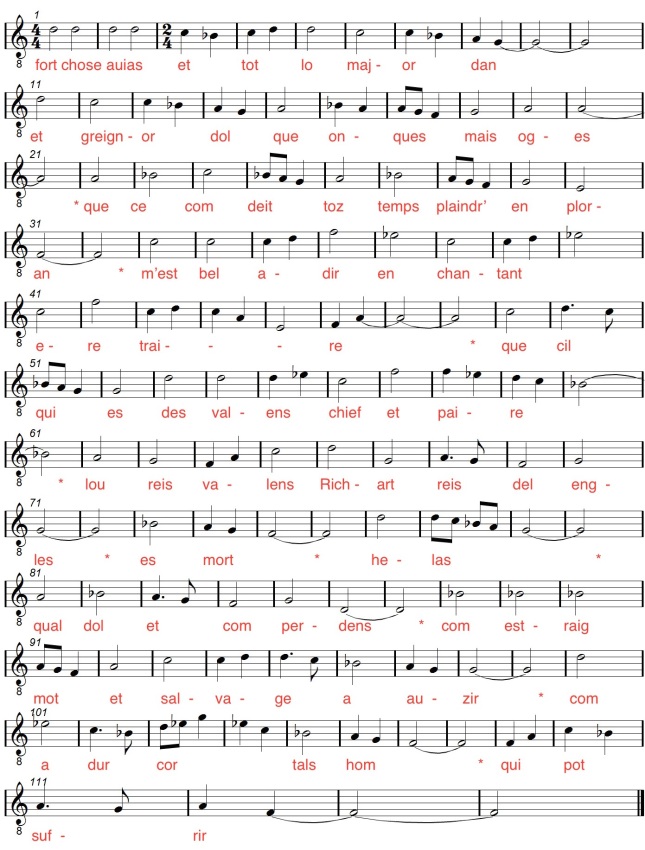
Magna Melodia is our concert programme for 2015, in honour of the 800th anniversary of the Magna Carta. The initial agreement of the Great Charter lies smack in the middle of the period of music that we are most interested in, and so this noteworthy anniversary has provided an admirable spur to us to gather a good range of material into a great programme. Magna Melodia is available for concert bookings in 2015 (with several already signed up!), and also as a programme of linked presentations at medieval festivals or other medieval events. And we are going to put it all together into a CD as well – which will also be available as a digital download.
Magna Melodia presents music from the world of the early Plantagenet kings – Henry II, his sons Richard and John, and his grandson Henry III. As you can see, the timespan is thus c1150 – c.1250. Geographically, the programme goes from England (of course!) to Sicily via the trouveres of northern France and the troubadours of the south. We have been able to include a great deal of our existing repertoire but have also moved into new pastures and new repertoire. Magna Melodia is at this time still to some extent a work in progress – we are trying out different options and thinking what will match up best to make the most satisfying programme – but here’s an idea of what we have in mind.
‘Volez vous que je vous chant’ is a beautiful anonymous trouvère reverdie – it recounts a dream. We’ve chosen this as our introductory piece as it is redolent of so much that was key to the musical scene in the early thirteenth century. The song conjures up the world of the aristocratic music-makers of both northern and southern France
“Do you want me to sing you a song of love? This was not written by a common man – a knight composed this song, sitting in the shade of an olive tree in the arms of his beloved…”
The song goes on to paint a portrait of an idealised woman, not exactly human:
“the nightingale was my father, who sings on the branch and in the high hedges; the siren was my mother, who sings in the salty sea and on the high riversides”
This made me think of the legend of Melusine – the fairy woman, daughter of the devil, who was believed to be the distant ancestor of the Plantagenet kings. From the devil they came, it was said, and to the devil they would return…
Richard, John and Henry III had this devil’s inheritance on one side, but on the other – through their mother Eleanor – they had the heritage of Aquitaine, the very heartland of the troubadour tradition. Troubadour music was woven into the lives of the sons of Henry II and as patrons and friends of many composers they are often referenced in specific songs. Henry the Young King, the initial son and heir of Henry II, was the subject of a renowned planh, or lament, by Bertran de Born. Unfortunately, the music for this planh has not survived but we intend to present a partial narration of this lament against the instrumental background of another de Born melody. Alongside this we will present Gaucelm Faidit’s planh on the death of Richard the Lionheart. King John fared less well at the hands of the troubadours, being noticeably criticised by de Born’s son, another Bertran:
“… his heart is soft and cowardly and no man should ever trust him.”
Troubadour music is also represented by a pair of songs by Bernart de Ventadorn, closely associated with Eleanor of Aquitaine: at present we are intending to pair ‘Can vei la lauzeta’ and ‘La dousa votz’. We may also include one or more tunes by Marcabru.
Staying in Aquitaine, we have been investigating the rich repertoire of religious polyphony from the region. We are working on ‘Lux refulget’, an example of the new style of florid organum where the melody is at times maintained in slow held notes in the tenor and decorated by fluid and lively melismas in the upper voice. We are using Paris ms. lat. 3719, one of the manuscripts closely associated with the abbey of St Martial in the Limoges.
We are really pleased to be including some Sicilian material. The Norman kingdom of Sicily was associated with the Angevins through the marriage of Henry and Eleanor’s daughter Joanna to King William II. Joanna spent her earliest years at the abbey of Fontevraud with her brother John, her near contemporary. King William died unexpectedly and young, and Joanna was taken prisoner by the new king Tancred, who had seized the throne in default of any clear male heir. She was rescued from this ignominious state by the arrival of her elder brother Richard, now king of England, and went on to accompany him on his crusade to the Holy Land.
The fabulously rich kingdom of Sicily was a vibrant mixture of traditions – Norman, Byzantine, Saracen, and three books of music from the Norman Sicilian church are extant in the Biblioteca Nacional in Madrid; they contain much liturgical music and also more informal songs of praise and celebration. We include several of these in Magna Melodia. For all the cultural diversity of Sicily, this church music can be shown to derive clearly from the practices of the church back in Normandy and northern France. Indeed, some pieces, like Orientis Partibus, are also known from later northern French sources.
This Sicilian link thus returns us back to northern France. The trouvère tradition is not so strongly linked to the Angevins as is that of the troubadours, but King Richard himself wrote in French as a trouvère and we will certainly include his plaintive ‘Ja nus hons pris’, alongside the roughly contemporaneous anonymous crusade song ‘Parti de mal’, which survives appended to a work dedicated to Henry II. This song, which was perhaps written by someone working in the royal Chancery, appears to reference the king and his sons:
“my good lords whom I have loved so much that I almost forgot God!”
Other trouvère material to be featured may include instrumental versions of anonymous pastourelles. Staying in northern France we intend also to include a selection of melodies from the Ludus Danielis, the play of Daniel originating at Beauvais in – it is thought – the late twelfth century.
Which leaves us finally, and necessarily, in England. We aim to include here too both music of the church and secular music. For the former, we have been working on the polyphonic Verbum patris humanatur, a lively new year celebratory song. It’s important to realise that for secular music the Anglo-Norman and Angevin aristocracy of England would have been enjoying the repertoire of the troubadours and trouvères, just like their continental cousins but, that said, there is also some music extant in English. We will certainly feature ‘Miri it is’, and are also working on ‘Man mei long him lives wene’ and ‘Foweles in the frith’, although this last may take us too far out of our time frame.
So, as you can see, the programme is still somewhat up for grabs, but we think that it is shaping up well and we are very much looking forward to presenting this broad sweep of music from the time of England’s Angevin kings. This really was the age of magnificent melody, whether in the monophonic song or in the excitingly blended lines of polyphony. We aim to bring these melodies to life with a range of contemporary instrumentation and show what a wonderful musical world this was.
If you are interested in booking Trouvère for Magna Melodia do get in touch! We’ll be putting up some tasters of Magna Melodia over the next few months. And if you have any comments or suggestions for inclusions in the programme, we’d love to hear them.

 http://www.medievalminstrels.com
http://www.medievalminstrels.com
http://www.facebook.com/Trouvere.Medieval.Minstrels
 a sword in his right hand and the orb in his left hand. The other side of the seal – the reverse – showed the monarch on horse back, in the characteristic knightly pose: horse at the gallop, knight in full armour with sword raised to the back. This double-faced style of seal was instituted in this country by William the Conqueror, and remains in place to this day with the reverse of the current royal seal showing Queen Elizabeth on horseback as the Colonel-in-Chief of the Grenadier Guards and the obverse showing her ‘in majesty’ with the sceptre and the orb,
a sword in his right hand and the orb in his left hand. The other side of the seal – the reverse – showed the monarch on horse back, in the characteristic knightly pose: horse at the gallop, knight in full armour with sword raised to the back. This double-faced style of seal was instituted in this country by William the Conqueror, and remains in place to this day with the reverse of the current royal seal showing Queen Elizabeth on horseback as the Colonel-in-Chief of the Grenadier Guards and the obverse showing her ‘in majesty’ with the sceptre and the orb,




